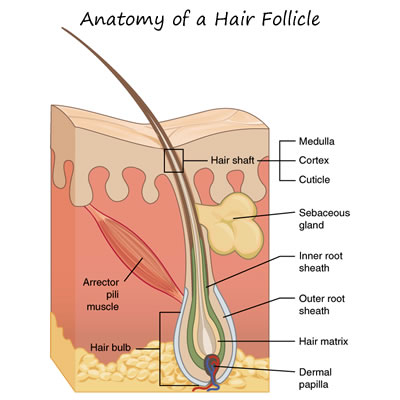A Patient's Guide to Pre-Operative Hair Removal for Vaginoplasty
 Pre-operative hair removal is considered a medical necessity for most forms of Vaginoplasty procedures. There's a lot to learn about hair removal before starting treatment, and the more you know the more likely you are to hit your hair removal target before surgery. This patient guide addresses the critical aspects of hair removal as it relates to Vaginoplasty and offers tips to help you get the most out of your treatment.
Pre-operative hair removal is considered a medical necessity for most forms of Vaginoplasty procedures. There's a lot to learn about hair removal before starting treatment, and the more you know the more likely you are to hit your hair removal target before surgery. This patient guide addresses the critical aspects of hair removal as it relates to Vaginoplasty and offers tips to help you get the most out of your treatment.
Pre-operative hair removal is typically required for Penile Inversion, Penile Preservation, and Peritoneal Vaginoplasty procedures as hair-bearing skin is used to line the vaginal cavity and will be largely inaccessible for post-operative hair removal. The use of hair-bearing skin in Vaginoplasty procedures can cause post-operative hair growth in the vagina and urethra which can lead to irritation, infections, and hairball and stone formation.1 Technically, post-operative hair removal is possible—hairs can be removed with tweezers or a gynecologist can burn the hairs with surgical cautery—however finding a provider to do this can be difficult and the experience is less than pleasant.
With the Vulvoplasty (Minimal Depth) procedure, the hair-bearing skin remains accessible so hair removal can be done after surgery as but it's still recommended to complete hair removal before surgery.
Those seeking hair removal before Vaginoplasty have three treatment options: Electrolysis, Laser Hair Removal, or a combination of both.
What Is Electrolysis?
Electrolysis is the process of electric epilation. In use since the late 1800s, electrolysis is approved by the US FDA for "permanent hair removal." There are three electrology modalities: galvanic, thermolysis and blend (galvanic and thermolysis combined.)
The galvanic method, established in 1875, removes hair through chemical decomposition, the result of the application of a direct electrical current to the hair follicle. Body salts and moisture in body tissue act as a salt water solution and applying the electrical current via a needle inserted into the hair follicle causes a chemical reaction that produces sodium hydroxide (lye) which destroys the follicle. Two electrodes are required: one electrode is the electrology needle and the other is usually a metal wand held in the patient's hand. The process is slow, requiring about two minutes to generate enough lye to kill the follicle. A newer variation of galvanic electrolysis is the multiple needle method which allows 12-16 hairs to be treated simultaneously. The galvanic method kills about 80% of the follicles treated.
 The thermolysis method, first put into practice in 1923, destroys the hair follicle by heat. It's also referred to as shortwave method, high frequency method or diathermy. Thermolysis is the most widely practiced method of electrolysis available today. High frequency radio energy is applied to the hair follicle via an electrolysis needle causing heat, which destroys the follicle. This process works faster than galvanic. It's well suited to thin, shallowly rooted hairs and less effective on larger, courser and more deeply rooted hairs. The thermolysis method kills about 5-15% of the follicles treated.
The thermolysis method, first put into practice in 1923, destroys the hair follicle by heat. It's also referred to as shortwave method, high frequency method or diathermy. Thermolysis is the most widely practiced method of electrolysis available today. High frequency radio energy is applied to the hair follicle via an electrolysis needle causing heat, which destroys the follicle. This process works faster than galvanic. It's well suited to thin, shallowly rooted hairs and less effective on larger, courser and more deeply rooted hairs. The thermolysis method kills about 5-15% of the follicles treated.
The blend method is the combination and simultaneous use of galvanic and thermolysis techniques, and has the benefit the effectiveness of galvanic with the better speed of thermolysis, needing about 10 seconds for each follicle. The blend method kills about 70-80% of the follicles treated.
With electrolysis, "hair reductions up to 90% have been reported, with regrowth ranging from 15-50%."2 Ultimately, the effectiveness of each method highly depends on the skill of the electrologist.
A benefit of electrolysis is that unlike laser hair removal its effectiveness does not depend on hair color. Electrology sessions are usually 1-2 hours long.
Looking for an electrologist in the USA? Find one here.
What Is Laser Hair Removal?
Laser Hair Removal (LHR) reduces the number of hairs by damaging the follicle's hair bulb versus targeting the entire follicle as electrolysis does. LHR is a more recent innovation, with the first laser used for hair removal in 1960. LHR is approved by the US FDA for "permanent hair reduction." As LHR targets hair pigment, it achieves its best results when used to remove dark hair from light skin. It's not effective for treating red, grey, white and blonde colored hair. LHR machines use different types of lasers and you'll want to learn more about different laser types and find out which types are locally available and would work best for you. For example, those with darker skin should be treated with machines that use longer wavelength lasers.3
A benefit of LHR over electrolysis is that a larger area can be treated in a much shorter time, which also means that it's usually cheaper in the long run than electrolysis. LHR sessions are usually 15-30 minutes long.
Several studies concluded that LHR "demonstrated the longest hair-free period for removal of unwanted hair4 and a review of 30 controlled trials also concluded that LHR is more effective than electrolysis.
According to a 2016 study about LHR for gender reassignment surgery: 5
- Alexandrite-LHR provides higher clearance rates than electrolysis (74% vs. 35%, respectively) 6 months following treatment, is 60 times faster and less painful, and requires fewer treatment sessions.
- Electrolysis may be cheaper per session, but many hours may be required to treat each area of hair; in contrast, LHR will treat the entire area for hair removal during each session with faster procedure times, low occurrence of side effects, and fewer needed sessions.
- Reliance on [electrolysis] has persisted in public and professional transgender health care forums, despite the absence of evidence-based clinical guidelines or peer reviewed data to support favoring electrolysis over LHR.
- The shift towards LHR as a superior method of hair removal suggests that it should also be the treatment of choice prior to [Vaginoplasty].
What About Follicle Cautery During Surgery?
 There's a growing number of surgeons who don't require pre-operative hair removal for Vaginoplasty. Instead, they cauterize the hair follicles in the skin flap during surgery to help prevent hair regrowth in the vagina. This practice has not been well studied, however Dr. Gallagher has reported that so far none of her patients who have had intra-operative follicle cautery have had problems with hair growth in the vagina.
There's a growing number of surgeons who don't require pre-operative hair removal for Vaginoplasty. Instead, they cauterize the hair follicles in the skin flap during surgery to help prevent hair regrowth in the vagina. This practice has not been well studied, however Dr. Gallagher has reported that so far none of her patients who have had intra-operative follicle cautery have had problems with hair growth in the vagina.
Dr. Heidi Wittenberg, a San Francisco Urogynecologist who performs several methods of Vaginoplasty, cauterizes any follicle roots that were not caught by pre-operative hair removal before inserting the graft into the vagina. However, in terms of relying on this method alone she warns that 17% of hair follicles will be dormant and missed by this process, and that some follicles are resilient and will still grow back after cautery.
 Dr. John Whitehead, a Vaginoplasty Surgeon in Miami, agrees. "In my practice, hair removal prior to Vaginoplasty is suggested but not mandatory. We remove hair at the time of surgery, however hair grows in stages and whatever we do in the operating room will reduce overall hair growth but will not remove all of it." Dr. Whitehead warns that the presence of hair in the vagina can cause chronic irritation and infection, as well as a tugging, unpleasant sensation during intercourse.
Dr. John Whitehead, a Vaginoplasty Surgeon in Miami, agrees. "In my practice, hair removal prior to Vaginoplasty is suggested but not mandatory. We remove hair at the time of surgery, however hair grows in stages and whatever we do in the operating room will reduce overall hair growth but will not remove all of it." Dr. Whitehead warns that the presence of hair in the vagina can cause chronic irritation and infection, as well as a tugging, unpleasant sensation during intercourse.
Additionally, cauterizing a large number of dense follicle roots can increase the risk of infection and scarring, and thinning the flap compromises the blood supply and could increase wound complications.6
So, while intra-operative cautery to remove hair for Vaginoplasty is possible, most Vaginoplasty surgeons believe pre-operative hair removal adds a margin of safety.
How Long Will Hair Removal Take?
The length of time to complete hair removal before Vaginoplasty is variable, based on the skin flaps being used, the density of hair, and the hair and skin color.
Hair grows in cycles and it's important to understand this cycle because hair removal is only effective during the active growth phase of the cycle. When you start hair removal, about 25% of the hair follicles will be in the active stage, while others will be in the transitional and resting phases. Only the hairs in the active phase will be affected by electrolysis or LHR. Many surgeons recommend planning for 6-12 months of hair removal, followed by a wait time of 3 months to confirm that regrowth won't occur.
Be sure to get guidance from your surgeon about the location and dimensions of the areas that need to be hair-free. Dr. Wittenberg requires the following areas to be hair-free prior to surgery: one inch around the base of the penis, all hair on the scrotal skin, and 2.5 inches on the perineum. Templates for hair removal are available on her website.
Starting hair removal prior to your initial consultation can result in shorter wait times for surgery. For example, if 6-12 months of hair removal has been completed by the time of your consult, and provided that you have the appropriate letters recommending surgery, surgery with Dr. Wittenberg can be scheduled within 3 months of your consult.
Are There Ways To Reduce Pain From Hair Removal?
Unfortunately, electrolysis can be painful. The sensation is like stinging or burning and is intensified when electrolysis is performed on sensitive areas like the scrotum. While everyone has different pain thresholds, why put yourself through more pain than is necessary when there are ways to help reduce it?
- Getting a good night's sleep the night before your electrolysis session is a simple trick that can help. A lack of lowers your pain threshold, making you more sensitive to pain and intensifying your pain. 7
- Another simple trick is to increase your water intake. Research has found that dehydration can increase pain sensitivity. 8
- Take Acetaminophen 30-45 minutes before your session. Avoid Aspirin and Ibuprofen as these can thin the blood and increase the risk of bleeding and bruising.
- Topical numbing creams are another good option for decreasing pain from electrolysis. Eutectic Mixture of Local Anaesthetics (EMLA) cream contains lidocaine and prilocaine and is available over the counter. Applied immediately before your session, EMLA can provide significant pain relief. Speak with your electrologist to determine the best time to apply EMLA cream.
 Speak with your surgeon or electrologist to find out if you can get a scrotal block—also called a spermatic cord anesthesia block—prior to your electrolysis session. This involves getting a lidocaine injection into the spermatic cord. This will numb areas up to three hours. Dr. Nick Esmonde uses bupivicaine instead of lidocaine as the effects last much longer, between 4-8 hours. In addition to injecting into the spermatic cord, Dr. Esmonde also does a diffuse midline injection into the scrotal nerve. Scrotal blocks allow a longer duration of an electrolysis session with greater clearance of hair. The result is less pain plus fewer overall number of sessions, which reduces cost.
Speak with your surgeon or electrologist to find out if you can get a scrotal block—also called a spermatic cord anesthesia block—prior to your electrolysis session. This involves getting a lidocaine injection into the spermatic cord. This will numb areas up to three hours. Dr. Nick Esmonde uses bupivicaine instead of lidocaine as the effects last much longer, between 4-8 hours. In addition to injecting into the spermatic cord, Dr. Esmonde also does a diffuse midline injection into the scrotal nerve. Scrotal blocks allow a longer duration of an electrolysis session with greater clearance of hair. The result is less pain plus fewer overall number of sessions, which reduces cost.
Will Insurance Pay for Hair Removal?
While some insurance plans in the US pay for pre-operative hair removal, many people have to pay out of pocket for treatments. The cost of hair removal is determined by a number of factors and is therefore difficult to estimate. Because electrolysis is more expensive, you can save money by starting with LHR to thin out a large area quickly before moving on to electrolysis.
You can review excerpts from various health insurance medical policies that have explicit provisions detailing when electrolysis or laser hair removal is covered for transgender people here.
For those with insurance that will cover hair removal, Dr. Wittenberg will provide a letter at the initial consult for patients to submit to their insurance to facilitate coverage. If you have not had a surgical consultation and would like to get started on hair removal, ask your hormone or primary care specialist to write a letter stating that hair removal is medically necessary for your surgery.
Hair removal is an important part of reducing complications and ensuring patient satisfaction after Vaginoplasty. While there's little research that has been done to gauge the most effective means of hair removal for gender-affirming surgery, both electrolysis and laser hair removal have demonstrated their usefulness.
Footnotes
1. Zhang WR, Garrett GL, Arron ST, Garcia MM. Laser hair removal for genital gender affirming surgery. Translational Andrology and Urology. 2016;5(3):381-387.
2. Zhang et. al.
3. Zhang et. al.
4. Zhang et. al.
5. Zhang et. al.
6. Hadj-Moussa M, Ohl DA, Kuzon WM. Feminizing Genital Gender-Confirmation Surgery. Sex Med Rev 2018.
7. Sharecare. How can lack of sleep increase pain? Accessed 04/29/21.
8. NeuroscienceNews.com,
Feb 22, 2016. Dehydration Increases Pain Perception and Reduces Blood Flow in the Brain. Accessed 04/29/21.
Last updated: 07/12/21